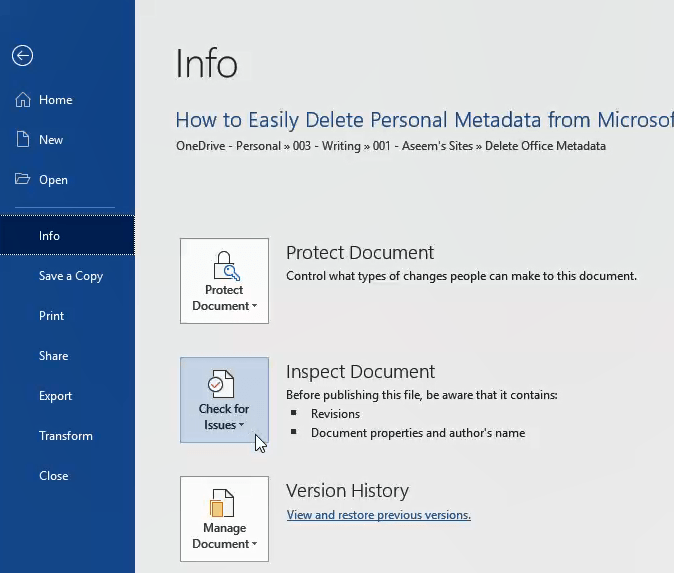- Microsoft Word Metadata Fields
- Microsoft Word For Mac See Metadata Windows 10
- How To Remove Metadata From Word For Mac
- Microsoft Word For Mac Student
- Microsoft Word For Mac Free
In addition, most software programs or file formats include placeholders or standards for specific types of metadata. A common example is Microsoft Word, which by default is likely to include information about the author, the date when the document was created, and any embedded comments or revisions. On a Mac operating system. Learn how to remove Metadata in Word 2010. Click the File Tab in 2010 and click on Info, then Check for Issues and select Inspect Document.To view the Personal Information click on Show All Properties to the right.
Jul 03, 2017 When you print a document in Microsoft Word 2000, Microsoft Word 2002,Microsoft Office Word 2003, or Microsoft Office Word 2007 an additional page is printed that contains information about the document. Word Document on Mac. Scrubbing metadata was simplified in the current version of Word 2016 for Mac. For instructions on how to download Office 2016, pleas review the Office 365 article. Remove metadata from a Word document in macOS by using the short process below. Navigate to Tools Protect Document. Mar 20, 2015 Metadata in Microsoft Word documents 20 March 2015 by Martin Fenner Metadata such as author, title, journal or persistent identifier are essential for scholarly documents, and some of us are spending a significant part of our time adding or fixing metadata. Mar 19, 2020 How do I view metadata in any of my Word documents? Skip to main content. You can help protect yourself from scammers by verifying that the contact is a Microsoft Agent or Microsoft Employee and that the phone number is an official Microsoft. Word / Mac / Office 2011 for Mac; Answer Rich Michaels - MVP. Microsoft does not support the automatic removal of hidden information for signed or protected documents, or for documents that use Information Rights Management (IRM). The Document Inspector in Word, Excel, and PowerPoint includes the following enhancements. This includes metadata, SharePoint properties, custom properties, and other.
The Document Inspector gives users an easy way to examine documents for personal or sensitive information, text phrases, and other document contents. They can use the Document Inspector to remove unwanted information; for example, before distributing a document.
Note
Microsoft does not support the automatic removal of hidden information for signed or protected documents, or for documents that use Information Rights Management (IRM). We recommend that you run the Document Inspector before you sign a document or invoke IRM on a document.
As a developer, you can use the Document Inspector framework to extend the built-in modules and integrate your extensions into the standard user interface.
The Document Inspector in Word, Excel, and PowerPoint includes the following enhancements.
Built-in Document Inspector modules
The Document Inspector has modules that help users inspect and fix specific elements of a given document. The Document Inspector includes the following built-in modules.
For all Office documents
- Embedded documents
- OLE objects and packages
- Data models
- Content apps
- Task Pane apps
- Macros and VBA modules
- Legacy macros (XLM and WordBasic)
For Excel documents
- PivotTables and slicers
- PivotCharts
- Cube formulas
- Timelines (cache)
- Custom XML data
- Comments and annotations
- Document properties and personal information
- Headers and footers
- Hidden rows and columns
- Hidden worksheets and names
- Invisible content
- External links and data functions
- Excel surveys
- Custom worksheet properties
For PowerPoint documents
- Comments and annotations
- Document properties and personal information
- Invisible on-slide content
- Off-slide content
- Presentation notes
For Word documents
- Comments, revisions, versions, and annotations
- Document properties and personal information; this includes metadata, SharePoint properties, custom properties, and other content information
- Custom XML data
- Headers, footers, and watermarks
- Invisible content
- Hidden text
Opening the Document Inspector
To open the Document Inspector:
Choose the File tab, and then choose Info.
Choose Check for Issues.
Choose Inspect Document.
Use the Document Inspector dialog box to select the type or types of data to find in the document.
After the modules complete the inspection, the Document Inspector displays the results for each module in a dialog box. If a given module finds data, the dialog box includes a Remove All button that you can click to remove that data. If the module does not find data, the dialog box displays a message to that effect.
Microsoft Word Metadata Fields
If you choose to remove the data for a given module, the dialog box displays descriptive text that indicates whether the operation was successful or not. If the Document Inspector encounters errors during the operation, the module is flagged, displays an error message, and the data for that module does not change.
Support and feedback
Have questions or feedback about Office VBA or this documentation? Please see Office VBA support and feedback for guidance about the ways you can receive support and provide feedback.
-->Do you want to create a solution that extends the functionality of Word? For example, one that involves automated document assembly? Or a solution that binds to and accesses data in a Word document from other data sources? You can use the Office Add-ins platform, which includes the Word JavaScript API and the Office JavaScript API, to extend Word clients running on a Windows desktop, on a Mac, or in the cloud.
Word add-ins are one of the many development options that you have on the Office Add-ins platform. You can use add-in commands to extend the Word UI and launch task panes that run JavaScript that interacts with the content in a Word document. Any code that you can run in a browser can run in a Word add-in. Add-ins that interact with content in a Word document create requests to act on Word objects and synchronize object state.
Note
If you plan to publish your add-in to AppSource and make it available within the Office experience, make sure that you conform to the Commercial marketplace certification policies. For example, to pass validation, your add-in must work across all platforms that support the methods that you define (for more information, see section 1120.3 and the Office Add-in host and availability page).
The following figure shows an example of a Word add-in that runs in a task pane.
Figure 1. Add-in running in a task pane in Word
The Word add-in (1) can send requests to the Word document (2) and can use JavaScript to access the paragraph object and update, delete, or move the paragraph. For example, the following code shows how to append a new sentence to that paragraph.
You can use any web server technology to host your Word add-in, such as ASP.NET, NodeJS, or Python. Use your favorite client-side framework -- Ember, Backbone, Angular, React -- or stick with VanillaJS to develop your solution, and you can use services like Azure to authenticate and host your application.
The Word JavaScript APIs give your application access to the objects and metadata found in a Word document. You can use these APIs to create add-ins that target:
- Word 2013 or later on Windows
- Word on the web
- Word 2016 or later on Mac
- Word on iPad
Write your add-in once, and it will run in all versions of Word across multiple platforms. For details, see Office Add-in host and platform availability.
JavaScript APIs for Word
You can use two sets of JavaScript APIs to interact with the objects and metadata in a Word document. The first is the Common API, which was introduced in Office 2013. Many of the objects in the Common API can be used in add-ins hosted by two or more Office clients. This API uses callbacks extensively.
Microsoft Word For Mac See Metadata Windows 10
The second is the Word JavaScript API. This is a strongly-typed object model that you can use to create Word add-ins that target Word 2016 on Mac and Windows. This object model uses promises, and provides access to Word-specific objects like body, content controls, inline pictures, and paragraphs. The Word JavaScript API includes TypeScript definitions and vsdoc files so that you can get code hints in your IDE.
Currently, all Word clients support the shared Office JavaScript API, and most clients support the Word JavaScript API. For details about supported clients, see Office Add-in host and platform availability.
We recommend that you start with the Word JavaScript API because the object model is easier to use. Use the Word JavaScript API if you need to:
- Access the objects in a Word document.
Use the shared Office JavaScript API when you need to:

- Target Word 2013.
- Perform initial actions for the application.
- Check the supported requirement set.
- Access metadata, settings, and environmental information for the document.
- Bind to sections in a document and capture events.
- Use custom XML parts.
- Open a dialog box.
Next steps
How To Remove Metadata From Word For Mac
Ready to create your first Word add-in? See Build your first Word add-in. Use the add-in manifest to describe where your add-in is hosted, how it is displayed, and define permissions and other information.
Microsoft Word For Mac Student

To learn more about how to design a world class Word add-in that creates a compelling experience for your users, see Design guidelines and Best practices.
Microsoft Word For Mac Free
After you develop your add-in, you can publish it to a network share, an app catalog, or AppSource.